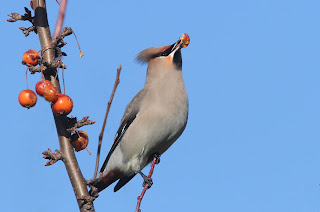 |
| Mistle Thrush in characteristic pose, high in tree cover (c. M.Finn) |
A couple of evenings ago, I noticed a clear chorus of bird song: the dusk chorus can be every bit as impressive as the dawn version, particularly so at this time of the year. With fewer species in song ( no spring migrants yet) the Song Thrushes and Mistles are much striking to my ears, especially if you get a calm evening.
With temperatures at the moment in double digits, thus encouraged, there is plenty of spring breeding behaviour: We are lucky enough to have Woodpeckers in our area, they are drumming in the distance, and chasing each other through the canopy. A pair of Buzzards are constantly mewing and undulating over the forest, escorting Kites and Ravens off their patch.
The flocks of Chaffinches and tit species show no sign of declining in numbers, but their songs are equally strong, and longer days are not far off.
 |
A barrel chested Mistle stands tall. (c. M Finn)
|
 |
| Soaring Buzzard, increasingly a common sight (c. M. Finn) |




















